This week, our In Focus section summarizes the Medicaid Long-Term Services and Supports (LTSS) Annual Expenditures Report, which the Centers for Medicare & Medicaid Services (CMS) released on October 17, 2023. The report includes detailed information about Medicaid LTSS expenditures for federal fiscal year (FY) 2020, which runs from October 1, 2019, through September 30, 2020. During this time, LTSS spending grew 20 percent to $199.4 billion from the previous year.
Medicaid LTSS Expenditures
Medicaid LTSS expenditures cover home and community-based services (HCBS), which includes personal care and home health, as well as institutional care, which includes services provided in nursing facilities, intermediate care facilities (ICF) for individuals with intellectual or developmental disabilities (IDD), and mental health facilities. HCBS accounted for 62.5 percent ($124.6 billion) of LTSS expenditures. The remaining 37.5 percent, or $74.8 billion, was directed toward institutional care (see Figure 1).
Figure 1. Medicaid LTSS Expenditures by Type
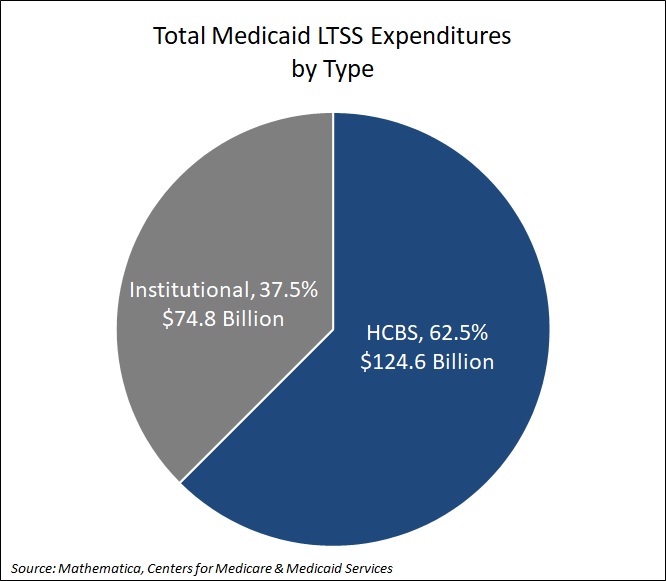
In addition, Section 1915c waiver program spending accounted for 43.1 percent of HCBS expenditures, followed by personal care at 20.5 percent. See Figure 2 for additional breakouts.
Figure 2. Percentage of Medicaid HCBS Expenditures by Service Category
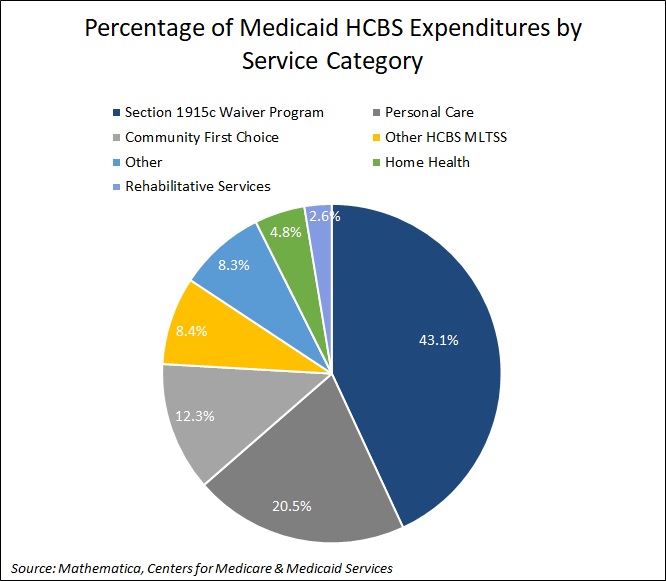
Nursing facilities accounted for the largest percentage (78.2 percent) of institutional care spending. See Figure 3 for additional breakouts.
Figure 3. Percentage of Medicaid Institutional Expenditures by Service Category
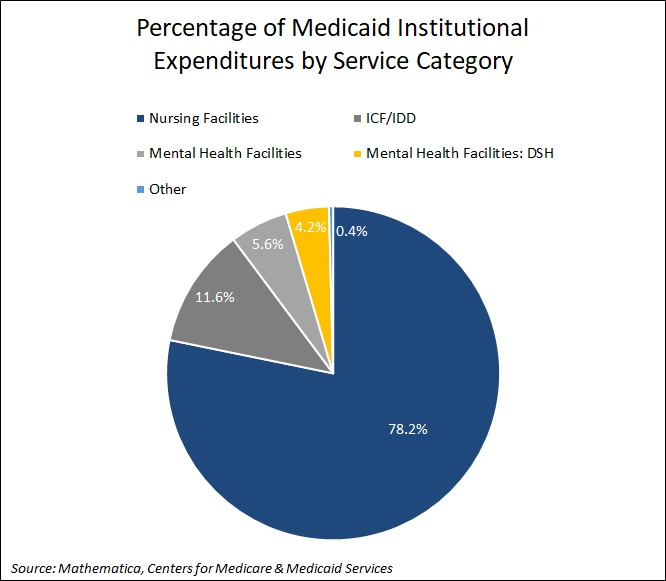
Medicaid LTSS spending accounted for 33.5 percent of total Medicaid spending in FY 2020. States with the highest LTSS as a percentage of total Medicaid spending were North Dakota at 54.9 percent, Wyoming at 54 percent, Kansas at 51.2 percent, Minnesota at 49.6 percent, and Nebraska at 45.2 percent. Texas and Virginia did not report spending for Medicaid LTSS programs, which comprise a substantial share of total LTSS expenditures in those two states (see Table 1).
Table 1. Medicaid LTSS Expenditures by State
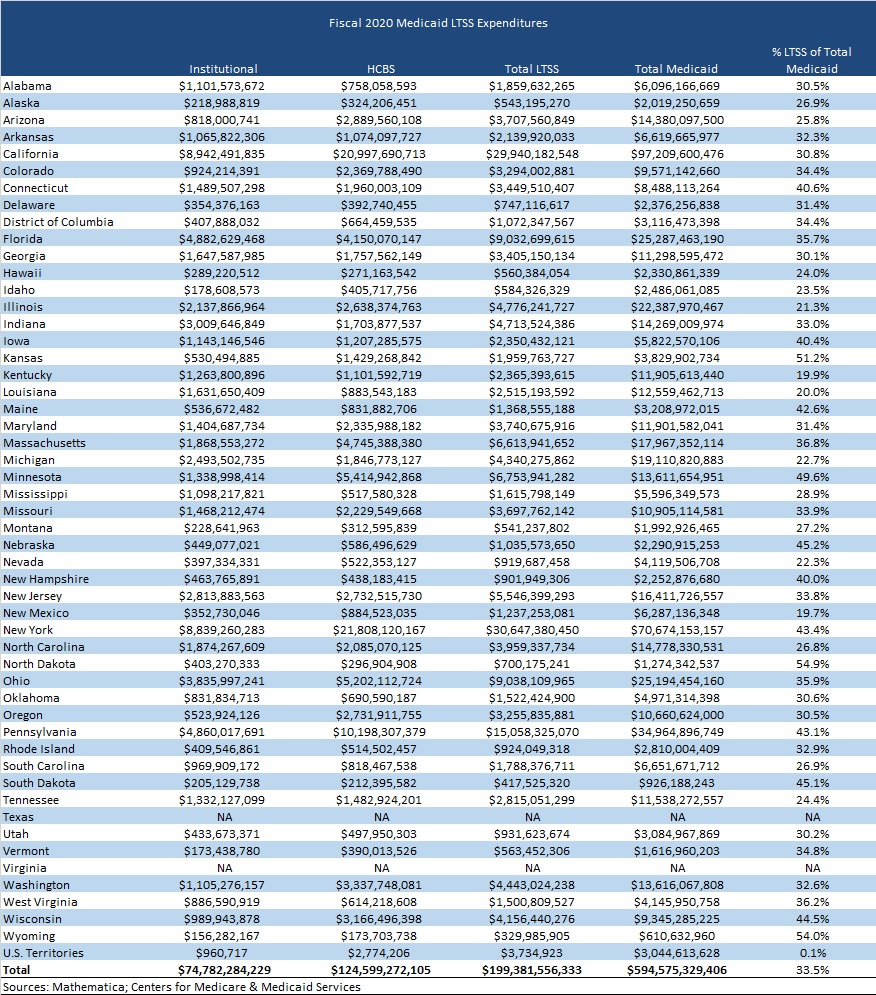
LTSS spending per resident also varied from state to state. On average, states spent $679 Medicaid LTSS dollars per state resident in FY 2020. Utah had the lowest Medicaid LTSS expenditures per state resident at $284, whereas the District of Columbia had the highest at $1,554 per resident.
Medicaid MLTSS Expenditures
Medicaid managed long-term services and supports (MLTSS) spending totaled $57 billion in FY 2020. HCBS accounted for $35.7 billion and institutional care accounted for $21.3 billion. As more states adopted and extended their Medicaid managed care programs, MLTSS spending grew 750 percent from FY 2008.
In FY 2020, 25 states had operational MLTSS programs. Of these, nine were Financial Alignment Initiative (FAI) capitated model demonstrations for dual eligible members. New York, Pennsylvania, Florida, and California accounted for 58 percent of total MLTSS spending nationally, with New York representing 23 percent of total national MLTSS expenditures. Three states—Idaho, Texas, and Virginia—did not report MLTSS spending (see Figure 4).
Figure 4. States with MLTSS programs, FY 2020
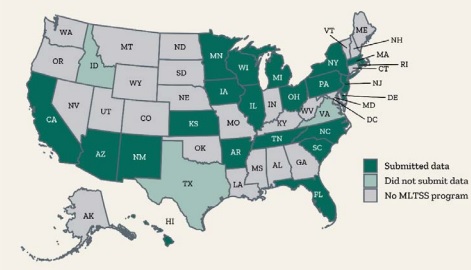
Iowa had the highest share of MLTSS expenditures as a percentage of total Medicaid LTSS expenses in FY 2020 at 95 percent. Arizona and Kansas followed at 94 percent and Hawaii at 74 percent. The national average was 29 percent. At the lowest end were South Carolina at 4 percent and Rhode Island at 12 percent, both of which are fee-for-service states. Michigan followed at 14 percent.
Contributing Factors to LTSS Expenditures
The COVID-19 public health emergency, which includes the first six months of the pandemic that started in March 2020, had a major effect on LTSS expenditures in FY 2020. Many residents in long term care facilities are covered by Medicaid and disproportionately experienced the most COVID-19 deaths. States began to implement various policies to address the impact of COVID-19 among Medicaid LTSS users. This includes modifying utilization limits for covered services and increasing payment rates for certain institutional services and HCBS.
As mentioned earlier, Texas and Virginia did not report Medicaid LTSS expenditures, which undercut the national total. Other factors that affect the reliability of Medicaid LTSS data include changes in state MLTSS expenditure reporting methods, and changes in state Medicaid LTSS policies and programs.
Note: CMS hired Mathematica to conduct the research, which used CMS-64 Medicaid expenditure report data, state-reported MLTSS data, Money Follows the Person (MFP) worksheets for proposed budgets, CMS 372 data on section 1915(c) waiver program population groups, and U.S. Census data to compile the report